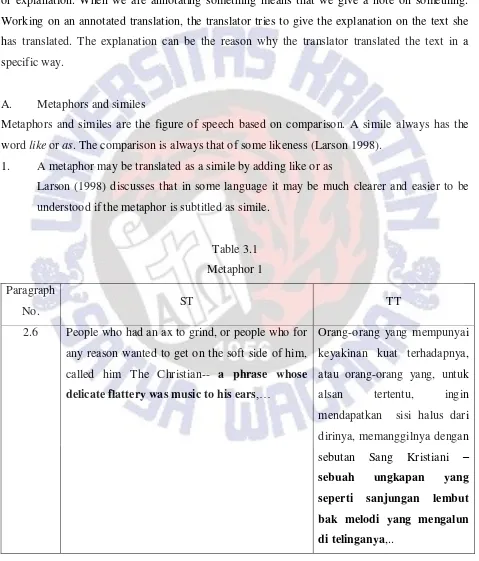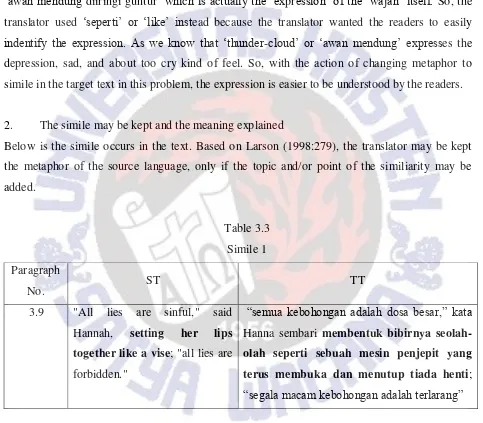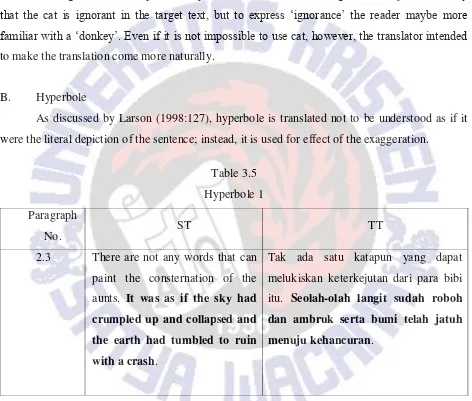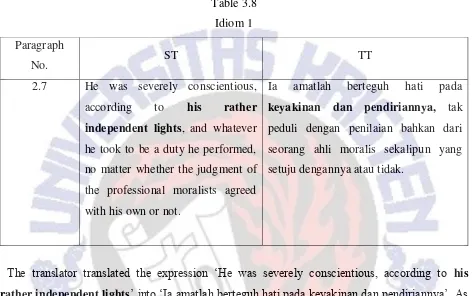49 CHAPTER III
ANNOTATION
According to Merriam-Webster dictionary annotation means adding a note of comment or explanation. When we are annotating something means that we give a note on something. Working on an annotated translation, the translator tries to give the explanation on the text she has translated. The explanation can be the reason why the translator translated the text in a specific way.
A. Metaphors and similes
Metaphors and similes are the figure of speech based on comparison. A simile always has the word like or as. The comparison is always that of some likeness (Larson 1998).
1. A metaphor may be translated as a simile by adding like or as
Larson (1998) discusses that in some language it may be much clearer and easier to be understood if the metaphor is subtitled as simile.
Table 3.1 Metaphor 1 Paragraph
No. ST TT
2.6 People who had an ax to grind, or people who for any reason wanted to get on the soft side of him, called him The Christian-- a phrase whose delicate flattery was music to his ears,…
50 Topic: Phrase whose delicate flattery
Image: Music to his hears Sense: delightful to be heard
Here, there is the comparison between words “phrase”, “delicate flattery”, and “music”. Those three words actually refers to one word that is “phrase”, but, because the “phrase” itself is a very beautiful phrase according to the writer, so he expressed this „phrase‟ is like a „delicate‟ which is „flattery‟ and a „music‟. Thus, rather than translate the metaphor with other metaphor in target text, the translator chose to translate it into simile. So, the comparison will be clear as in the target text. Basically, the translator translated the sentence above to „sebuah ungkapan yang seperti sanjungan lembut bak melodi yang mengalun di telinganya‟, or in English it will be „a phase which is like a delicate flattery as music to his ears…‟ because the most beautiful sound that can be heard by the ears is music, so „music‟ can express a kind of glad and pleased feelings by listening to it. This simile in target text is clearer and easier to be understood in what the writer was trying to talk about by the readers.
Table 3.2 Metaphor 2 Pragraph
No. ST TT
3.3 There stood the doctor, his face a thunder-cloud. Mother and child knew nothing of his presence;
Di sana berdirilah sang dokter, wajahnya seperti sebuah awan mendung diiringi guntur. Si ibu dan putrinya
tidak menyadari
kehadirannya;
Topic: Face expression Image: thunder-cloud
51 The translator translated the metaphor in table 3.2 is exactly the same as the source language. However, the translator used simile here and not metaphor because if the translator simply translated it into metaphor then the expressive word will sound unnatural even though the sense may be the same. If the metaphor is translated into „wajahnya adalah sebuah awan mendung‟ it doesn‟t really fit. How come „wajah‟ which refers to the part of the body become „awan mendung diiringi guntur‟ which is actually the „expression‟ of the „wajah‟ itself. So, the translator used „seperti‟ or „like‟ instead because the translator wanted the readers to easily indentify the expression. As we know that „thunder-cloud‟ or „awan mendung‟ expresses the depression, sad, and about too cry kind of feel. So, with the action of changing metaphor to simile in the target text in this problem, the expression is easier to be understood by the readers.
2. The simile may be kept and the meaning explained
Below is the simile occurs in the text. Based on Larson (1998:279), the translator may be kept the metaphor of the source language, only if the topic and/or point of the similiarity may be added.
Table 3.3 Simile 1 Paragraph
No. ST TT
3.9 "All lies are sinful," said Hannah, setting her lips together like a vise; "all lies are forbidden."
“semua kebohongan adalah dosa besar,” kata Hanna sembari membentuk bibirnya seolah-olah seperti sebuah mesin penjepit yang terus membuka dan menutup tiada henti; “segala macam kebohongan adalah terlarang”
Topic: lips which keeps blabbering Image: vise
Point of similiarity: keep open-close and never stop.
52 imagine that she keeps chatter here and there. The author describe the condition of Hannah‟s lips (which is keep blabbering) as a vise machine. Vise is tool that is usually attached to a table and that has two flat parts that can be opened and closed by a screw or lever in order to hold something. (Merriam-webster) So, we can depict that the condition of Hannah‟s lips kept open and close by her intention to lash out her interlocutors.
But, because an Indonesian word for vise, ragum, is not genuinely familiar to a target reader, the translator just translated it into mesin, the Indonesian form of „machine‟, but added some sense of how the machine works so that it resemble the lips that never stop open-close. In other words, the translator added the point of the similiarity in the target text or receptor text and kept the simile from the source text.
3. The meaning of simile may be translated without keeping the metaphorical imagery
There will be problems where the translator will simply translate the meaning of the simile and need to omit the simile itself.
Table 3.4 Simile 2 Paragraph
No. ST TT
3.37 "Hush! You are as ignorant as cats, both of you, and you don't know what you are talking about. You are like all the rest of the moral moles; you lie from morning till night, but because you don't do it…
“Huss! Kau memang sangat naif, kalian berdua, dan kau bahkan tak tahu apa yang sedang kau bicarakan. Kalian seperti tak bermoral; kalian berbohong dari pagi hingga malam, walau kalian tak melakukannya…
53 clueless, and uninformed. Those adjectives, in the context, are used to express that the person knows nothing about what she is talking about. The word „naif‟ itself may have a meaning as less experience, lack of information, or other adjective that connected with „ignorance‟. (Kamus Besar Bahasa Indonesia)
The translator chose to translate with omitting the simile in the source text because the „cat‟ in the target text is usually used to symbolize „clever‟. Even though it is also possible to say that the cat is ignorant in the target text, but to express „ignorance‟ the reader maybe more familiar with a „donkey‟. Even if it is not impossible to use cat, however, the translator intended to make the translation come more naturally.
B. Hyperbole
As discussed by Larson (1998:127), hyperbole is translated not to be understood as if it were the literal depiction of the sentence; instead, it is used for effect of the exaggeration.
Table 3.5 Hyperbole 1 Paragraph
No. ST TT
2.3 There are not any words that can paint the consternation of the aunts. It was as if the sky had crumpled up and collapsed and the earth had tumbled to ruin with a crash.
Tak ada satu katapun yang dapat melukiskan keterkejutan dari para bibi itu. Seolah-olah langit sudah roboh dan ambruk serta bumi telah jatuh menuju kehancuran.
In the sentence above, the expression used to describe the aunts‟ feeling is using hyperbole. As the translator, I tried to maintain the expected effect at a time deliver an appropriate meaning.
54 depressed at the same time, the feeling captured is like the sky had crumpled up and collapsed and the earth had tumbled to ruin with a crash. Then, the target language translated into “Seolah-olah langit sudah roboh dan ambruk serta bumi telah jatuh menuju kehancuran”. It is because the translator tries to make the meaning and the sense same as the target readers read it. The source text already has its sense hyperbole, so, the translator also tries to make the target text the same. The translator is talking about the “the earth had tumbled to ruin with a crash” part which is actually the translator could simply translate it into “bumi terguling dan hancur”, but, the translator translated into “bumi telah jatuh menuju kehancuran” instead. In the sentence doesn‟t really means that the sky had crumpled up and collapsed and the earth had tumbled to ruin with a crash, the things that is crumpled up, collapsed, and had tumbled to ruin with a crash is the aunts‟ consternation. The sky and the earth here may refer to the feeling of the aunts.
Table 3.6 Hyperbole 2 Paragraph
No. ST TT
3.6 I hadn't been able to determine what it was before. With one impulse the old ladies sprang to their feet, quaking with terror.
Sebelumnya, aku memang tak bisa memutuskan apa penyakitknya.
Dengan tiba-tiba saja wanita tua itu meloncat seketika, bergetar, terguncang, ketakutan, dan dipenuhi perasaan ngeri.
55 word suitable must be „tiba-tiba‟ and the translator also put „seketika‟ to give a sign to the target reader that the action was done in sudden act. Actually, both words „tiba-tiba‟ and „seketika‟ are the same in the term of meaning and the sense. The translator puts both words because the translator wants to overstate the sentence itself.
The other one is the sentence „quaking with terror‟ which is translated into „menjerit dengan nada yang menggelegar penuh rasa ngeri‟. According to Cambridge Dictionary, when a person is „quaking‟ means that the person is trembling or shivering because of a fear, and that person is „quaking with terror‟ means that extremely afraid. Therefore, to achieve the same expression in target language the translator made it into „bergetar, terguncang, ketakutan, dan dipenuhi perasaan ngeri.‟
Table 3.7 Hyperbole 3 Paragraph
No. ST TT
3.8 "She told a lie! Did she? God bless my soul! I tell a million a day! And so does every doctor. And so does everybody--including you-- for that matter.
“Dia mengatakan satu kebohongan! Betul kan? Diberkatilah jiwaku! Sejuta
kebohongan aku katakan dalam sehari, begitu pula setiap dokter! Dan begitu pula setiap orang termasuk dirimu.
As you take a look at the sentences in the table 3.7, the same hyperbole is used in both source text and target text. The sentence „I tell a million a day‟ is translated into „Aku katakan sejuta kebohongan dalam sehari‟. I tell „a million a day‟ doesn‟t really mean that the person really tells „a million‟, that is only the exaggerate expression to emphasize the person tells a lot of lies in a day even though that is not as many as a million. The Indonesian readers also familiar with the use of „sejuta‟ to refers to a huge amount of something. Thus, the translator didn‟t change the word „million‟in the target text.
56 To translate idioms, the translator needs to recognize the idiom itself in the source text to avoid the nonsense result of its literal translation. It will be more needful to translate with nonfigurative expressions (Larson 1998:125).
Table 3.8 Idiom 1 Paragraph
No. ST TT
2.7 He was severely conscientious, according to his rather independent lights, and whatever he took to be a duty he performed, no matter whether the judgment of the professional moralists agreed with his own or not.
Ia amatlah berteguh hati pada keyakinan dan pendiriannya, tak peduli dengan penilaian bahkan dari seorang ahli moralis sekalipun yang setuju dengannya atau tidak.
The translator translated the expression „He was severely conscientious, according to his rather independent lights‟ into „Ia amatlah berteguh hati pada keyakinan dan pendiriannya‟. As the translator looked up the dictionary of the idiom „according to one's own lights‟ means „according to the way one believes‟. Thus, since there is no equivalent idiom in target language, the translator tends to translate with its idiom‟s meaning. Therefore the translator translated it with a nonfigurative expression.
Table 3.9 Idiom 2 Paragraph
No. ST TT
2.6 People who had an ax to grind, or people who for any reason wanted to get on the soft side of him, called him The Christian.
57 dari dirinya, memanggilnya dengan sebutan Sang Kristen.
The idiom above is also translated with a nonfigurative expression. „An ax to grind‟ actually means to have a strong opinion on something that you want people to accept that and it makes you the reason why you want to do something. In other word, it is personal or selfish purpose. So, the translator translated it into „Orang-orang yang mempunyai tujuan untuk kepentingan diri sendiri‟ (pepole who have selfish reason). The sentence „tujuan untuk kepentingan diri sendiri‟ here is the people‟s personal and selfish aim for saying or doing something that make them called him by The Christian, according to the context of the story. Since there is also no equivalent idiom of that particular word in target text, it is also being translated by using the meaning of the idiom itself.
Table 3.10 Idiom 3 Paragraph
No. ST TT
3. 4 There, that will do--you're as sound as a nut!" He patted her cheek and added, "Run along now; I want to talk to these aunts."
Tapi tunggu, julurkan lidahmu. Bagus, sudah cukup. Kau seperti orang aneh saja!” Dia menepuk pipinya lalu berkata, “Pergilah sekarang, aku akan berbicara kepada para bibi.”
58 D. Personification
Personification that is a figurative language which makes a thing becomes a live object. Peter Samuel and David Frank (2000) said that personification is figure of speech where anything that inanimate is referred to as it were animate.
Table 3.11 Personification 1 Paragraph
No. ST TT
3.49 The color stole into the cheeks of both women, and with a struggle and an effort they got out their confession: "It was a lie."
Warna merah menyambar pipi kedua wanita itu, dan dengan perjuangan dan usaha, mereka memberikan sebuah pengakuan:
“Itu adalah sebuah kebohongan.”
The sentence „The color stole into the cheeks of both women‟ in the table 3.11 translated by the translator into Indonesia become „Warna merah tiba-tiba timbul di pipi kedua wanita itu.‟ Actually if the translator translated „The color‟ right away into the target text it would be „warna‟. Yet, the translator made it into „warna merah‟ (red color) because the context of the story is where two women made a shameful confession. So, when a person is ashamed the condition of their face usually will be associated with „red cheeks‟. Therefore, the translator translated it into „warna merah‟.
59 Table 3.12
Personification 2 Paragraph
No. ST TT
4.14 Hester was waiting, pale and trembling, in the hall. She whispered: "Oh, how did she take it--that poor, desolate mother?" Hannah's eyes were swimming in tears. She said: "God forgive me, I told her the child was well!"
Hester terlihat sedang menunggunya di depan ruangan, dengan wajah pucat dan bergetar. Ia berbisik:
“Oh, bagaimana seorang ibu yg malang dan menyedihkan itu dapat menerimanya?” Mata Hannah berenang dalam air mata. Ia berkata:
“Ampuni aku Tuhan, aku berkata bahwa anaknya baik-baik saja!”
60 Table 3.13
Personification 3 Paragraph
No. ST TT
7.1 A sheaf of white crape and black was hung upon the door of the house, and there it swayed and rustled in the wind and whispered its tidings. At noon the preparation of the dead was finished, and in the coffin lay the fair young form, beautiful, and in the sweet face a great peace.
Seikat kain sutra putih dan hitam tergantung di depan pintu rumah yang berayun oleh desiran angin dan membisikan berita duka. Pada tengah hari persiapan untuk pemakaman telah selsai, dan di dalam peti berbaringlah sesosok wajah muda yang cantik dan memancarkan kedamaian.
This problem occurs for the personification in table 3.13 is not different from the previous two personifications. As the long sentence above stated „A sheaf of white crape and black was hung upon the door of the house, and there it swayed and rustled in the wind
and whispered its tidings’ is indeed personification. There are „crape‟ that „whispered its









